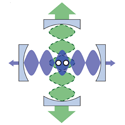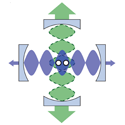Designer photon lifetimes
Several proposals for quantum information processing rely on precise control of photon lifetimes and the interactions between atoms and light. This can be achieved by cavity quantum electrodynamics—storing and studying light in a high-quality resonant structure. Ideally, one would want to store photons in such elements for a long time, but then read out the state of the stored mode quickly. With an eye toward scalable quantum computing devices, some of these capabilities have been implemented at microwave wavelengths on microfabricated chips in the form of “circuit QED.”
Writing in Physical Review Letters, Peter Leek and colleagues at the Eidgenössische Technische Hochschule in Zürich, Switzerland, report their ability to engineer very different photon lifetimes in two resonant modes of the same on-chip cavity. The trick used to achieve this is to couple radiation in and out of the center of the cavity, where only the full wavelength modes have a nonzero electric field. Sideband transitions couple qubits in the cavity to various resonant modes. Leek et al. observed a stored photon with a lifetime of microseconds in one mode, while the readout mode exhibited a lifetime of only nanoseconds. In addition to photon storage, Leek et al. were able to create Fock states (photon number coherent states) and Bell states (nonlocal entangled states), all essential steps toward useful quantum information processing building blocks. – David Voss





